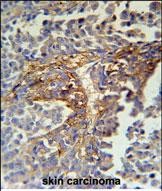ARMC5 Antibody (C-term)
Affinity Purified Rabbit Polyclonal Antibody (Pab)
- SPECIFICATION
- CITATIONS
- PROTOCOLS
- BACKGROUND

Application
| FC, IHC-P, WB, E |
|---|---|
| Primary Accession | Q96C12 |
| Other Accession | NP_079018.1, NP_001098717.1 |
| Reactivity | Human, Mouse |
| Host | Rabbit |
| Clonality | Polyclonal |
| Isotype | Rabbit IgG |
| Calculated MW | 97682 Da |
| Antigen Region | 599-628 aa |
| Gene ID | 79798 |
|---|---|
| Other Names | Armadillo repeat-containing protein 5, ARMC5 |
| Target/Specificity | This ARMC5 antibody is generated from rabbits immunized with a KLH conjugated synthetic peptide between 599-628 amino acids from the C-terminal region of human ARMC5. |
| Dilution | FC~~1:10~50 IHC-P~~1:50~100 WB~~1:1000 E~~Use at an assay dependent concentration. |
| Format | Purified polyclonal antibody supplied in PBS with 0.09% (W/V) sodium azide. This antibody is purified through a protein A column, followed by peptide affinity purification. |
| Storage | Maintain refrigerated at 2-8°C for up to 2 weeks. For long term storage store at -20°C in small aliquots to prevent freeze-thaw cycles. |
| Precautions | ARMC5 Antibody (C-term) is for research use only and not for use in diagnostic or therapeutic procedures. |
| Name | ARMC5 {ECO:0000303|PubMed:24283224, ECO:0000312|HGNC:HGNC:25781} |
|---|---|
| Function | Substrate-recognition component of a BCR (BTB-CUL3-RBX1) E3 ubiquitin ligase complex that terminates RNA polymerase II (Pol II) transcription in the promoter-proximal region of genes (PubMed:39504960, PubMed:39667934). The BCR(ARMC5) complex provides a quality checkpoint during transcription elongation by driving premature transcription termination of transcripts that are unfavorably configured for transcriptional elongation: the BCR(ARMC5) complex acts by mediating ubiquitination of Pol II subunit POLR2A phosphorylated at 'Ser-5' of the C-terminal domain (CTD), leading to POLR2A degradation (PubMed:35687106, PubMed:38225631, PubMed:39504960, PubMed:39667934). The BCR(ARMC5) complex acts in parallel of the integrator complex and is specific for RNA Pol II originating from the promoter-proximal zone: it does not ubiquitinate elongation-stalled RNA Pol II (PubMed:39667934). The BCR(ARMC5) complex also acts as a regulator of fatty acid desaturation by mediating ubiquitination and degradation of SCAP-free SREBF1 and SREBF2 (PubMed:35862218). Involved in fetal development, T-cell function and adrenal gland growth homeostasis (PubMed:24283224, PubMed:28676429). Plays a role in steroidogenesis, modulates steroidogenic enzymes expression and cortisol production (PubMed:24283224, PubMed:28676429). |
| Cellular Location | Nucleus. Chromosome. Cytoplasm. Note=Associates to RNA polymerase II (Pol II) on chromatin. |

Thousands of laboratories across the world have published research that depended on the performance of antibodies from Abcepta to advance their research. Check out links to articles that cite our products in major peer-reviewed journals, organized by research category.
info@abcepta.com, and receive a free "I Love Antibodies" mug.
Provided below are standard protocols that you may find useful for product applications.
References
Hattori, A., et al. DNA Res. 7(6):357-366(2000)
If you have used an Abcepta product and would like to share how it has performed, please click on the "Submit Review" button and provide the requested information. Our staff will examine and post your review and contact you if needed.
If you have any additional inquiries please email technical services at tech@abcepta.com.













 Foundational characteristics of cancer include proliferation, angiogenesis, migration, evasion of apoptosis, and cellular immortality. Find key markers for these cellular processes and antibodies to detect them.
Foundational characteristics of cancer include proliferation, angiogenesis, migration, evasion of apoptosis, and cellular immortality. Find key markers for these cellular processes and antibodies to detect them. The SUMOplot™ Analysis Program predicts and scores sumoylation sites in your protein. SUMOylation is a post-translational modification involved in various cellular processes, such as nuclear-cytosolic transport, transcriptional regulation, apoptosis, protein stability, response to stress, and progression through the cell cycle.
The SUMOplot™ Analysis Program predicts and scores sumoylation sites in your protein. SUMOylation is a post-translational modification involved in various cellular processes, such as nuclear-cytosolic transport, transcriptional regulation, apoptosis, protein stability, response to stress, and progression through the cell cycle. The Autophagy Receptor Motif Plotter predicts and scores autophagy receptor binding sites in your protein. Identifying proteins connected to this pathway is critical to understanding the role of autophagy in physiological as well as pathological processes such as development, differentiation, neurodegenerative diseases, stress, infection, and cancer.
The Autophagy Receptor Motif Plotter predicts and scores autophagy receptor binding sites in your protein. Identifying proteins connected to this pathway is critical to understanding the role of autophagy in physiological as well as pathological processes such as development, differentiation, neurodegenerative diseases, stress, infection, and cancer.




